1998 CADILLAC ELDORADO ESP
[x] Cancel search: ESPPage 214 of 380
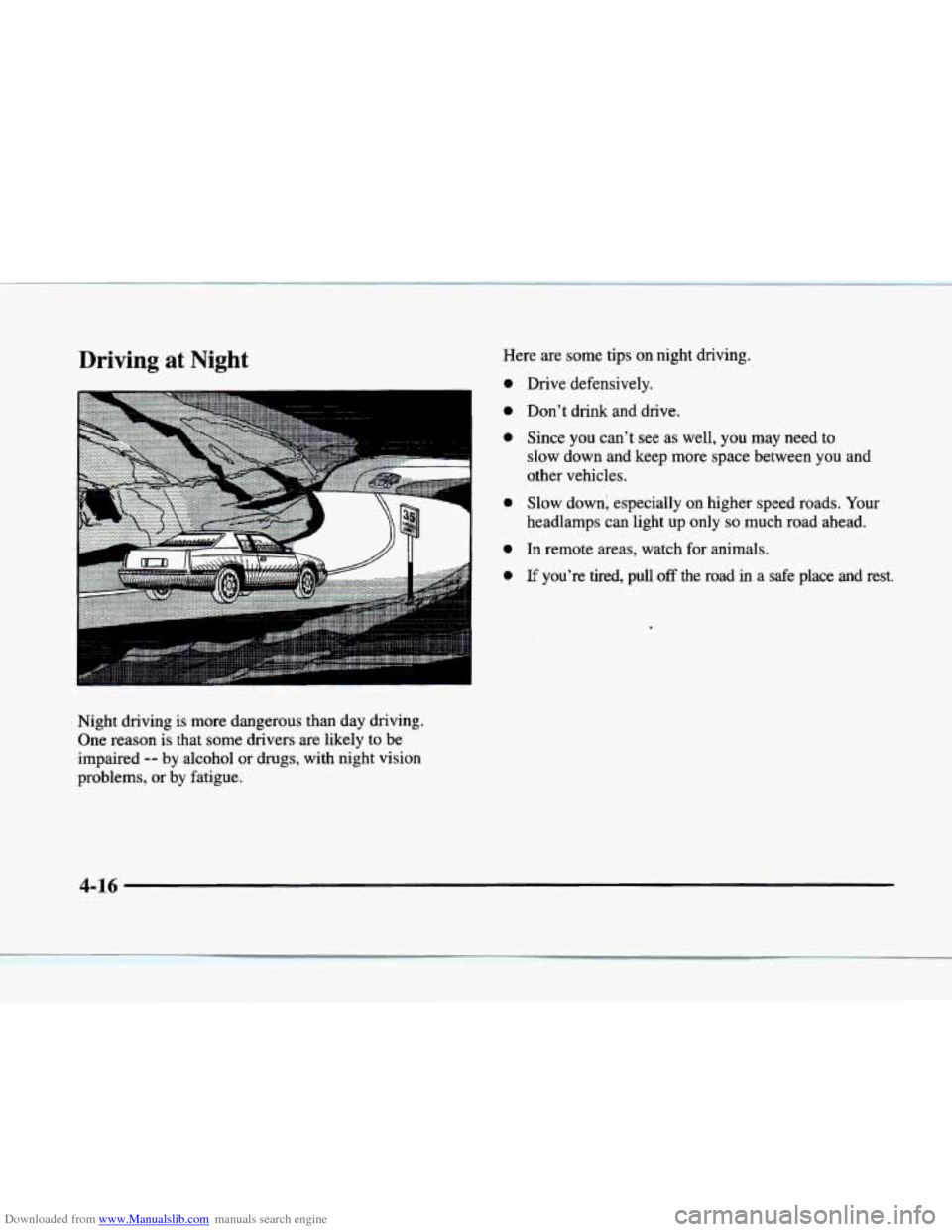
Downloaded from www.Manualslib.com manuals search engine Driving at Night Here are some tips on night driving.
. . . . . . . , . . . . . . . . . , . . . . . . . . .
Night driving is more dangerous than day driving.
One reason is that some drivers are likely
to be
impaired
-- by alcohol or drugs, with night vision
problems, or by fatigue.
0
0 0
0
0
0
Drive defensively.
Don’t drink and drive.
Since you can’t see as well, you may need to
slow down and keep more space between you and
other vehicles.
Slow down; especially on higher speed roads. Your
headlamps can light up only
so much road ahead.
In remote areas, watch for animals.
If you’re tired, pull .off the road in a safe place and rest.
4-16
Page 218 of 380
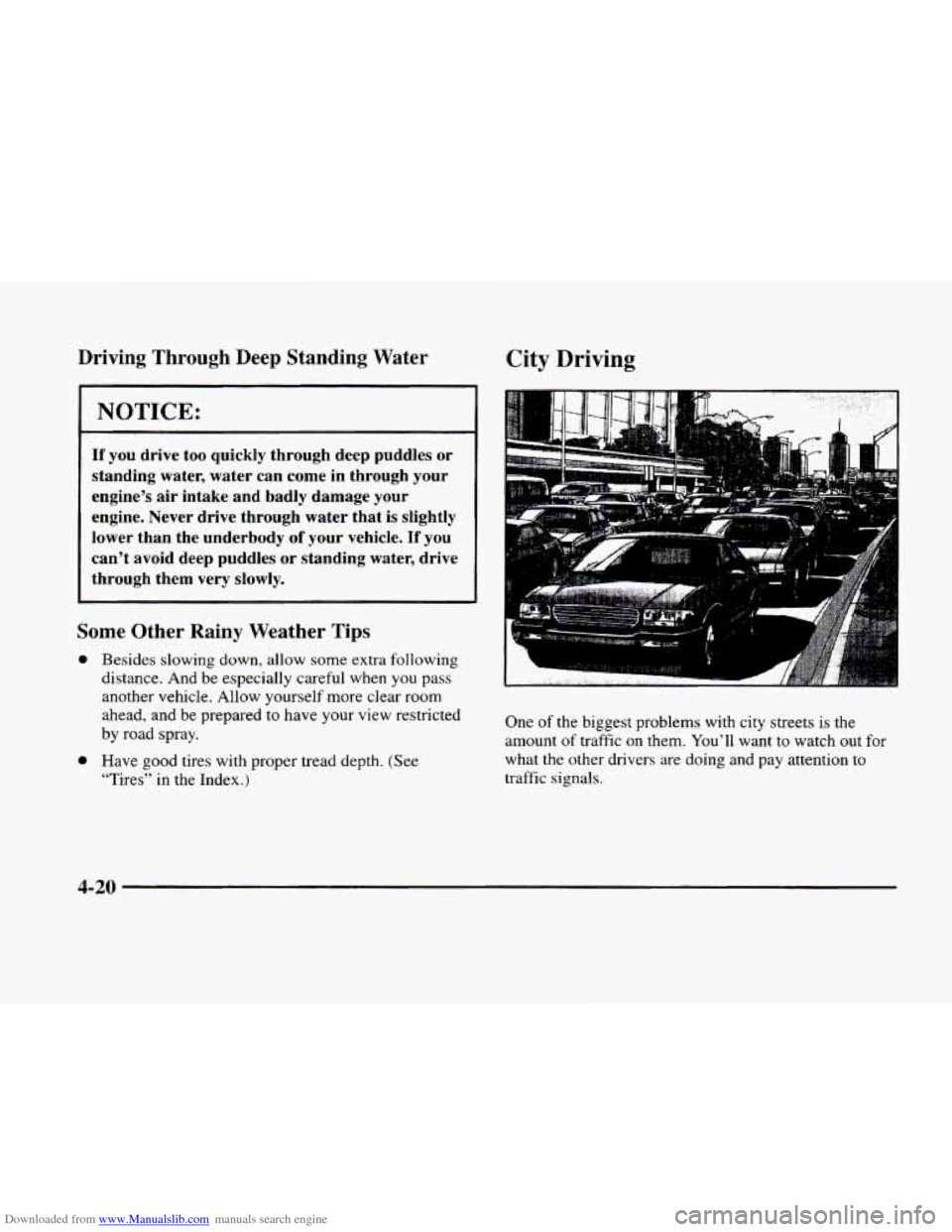
Downloaded from www.Manualslib.com manuals search engine Driving Through Deep Standing Water City Driving
NOTICE:
If you drive too quickly through deep puddles or
standing water, water can come in through your
engine’s air intake and badly damage your
engine. Never drive through water that is slightly
lower than the underbody
of your vehicle. If you
can’t avoid deep puddles or standing water, drive
through them very slowly.
some Other Rainy Weather Tips
0
0
Besides slowing down, allow some extra following
distance. And be especially careful when you pass
another vehicle. Allow yourself .more clear room
ahead, and be prepared to have your view restricted
by road spray.
Have good tires with proper tread depth. (See
“Tires” in
the Index.)
L
One of the biggest problems with city streets is the
amount of traffic on them. You’ll want to watch out
for
what the other drivers are doing and pay attention to
traffic signals.
4-20
Page 227 of 380
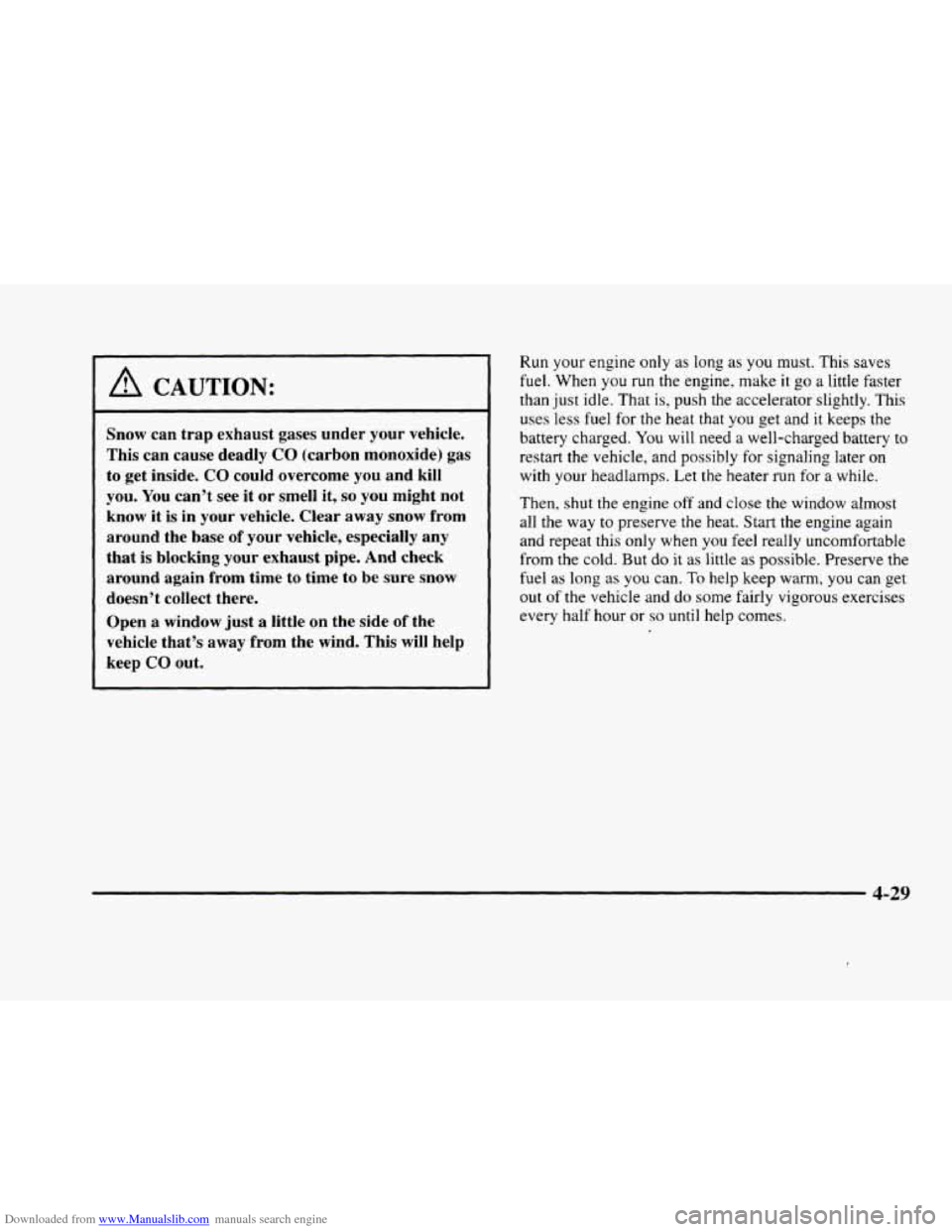
Downloaded from www.Manualslib.com manuals search engine I A CAUTION:
Snow can trap exhaust gases under your vehicle.
This can cause deadly
CO (carbon monoxide) gas
to get inside.
CO could overcome you and kill
you. You can’t see
it or smell it, so you might not
know it is in your vehicle. Clear
away snow from
around the base
of your vehicle, especially any
that is blocking your exhaust pipe.
And check
around again from time to time to be sure snow
doesn’t collect there.
Open a window just a
little on the side of the
vehicle that’s away from the wind.
This will help
keep
CO out.
Run your engine only as long as you must. This saves
fuel. When you run the engine. make it go a little faster
than just idle. That is, push the accelerator slightly. This
uses less
fuel for the heat that you get and it keeps the
battery charged.
You will need a well-charged battery to
restart the vehicle, and possibly for signaling later on
with your headlamps. Let the heater run for
a while.
Then, shut
the engine off and close the window almost
all the way
to preserve the heat. Start the engine again
and repeat this
only when you feel really uncomfortable
from the cold. But do it as little
as possible. Preserve the
fuel as long
as you can. To help keep warm, you can get
out of the vehicle and
do some fairly vigorous exercises
every half hour or
so until help comes.
4-29
Page 234 of 380
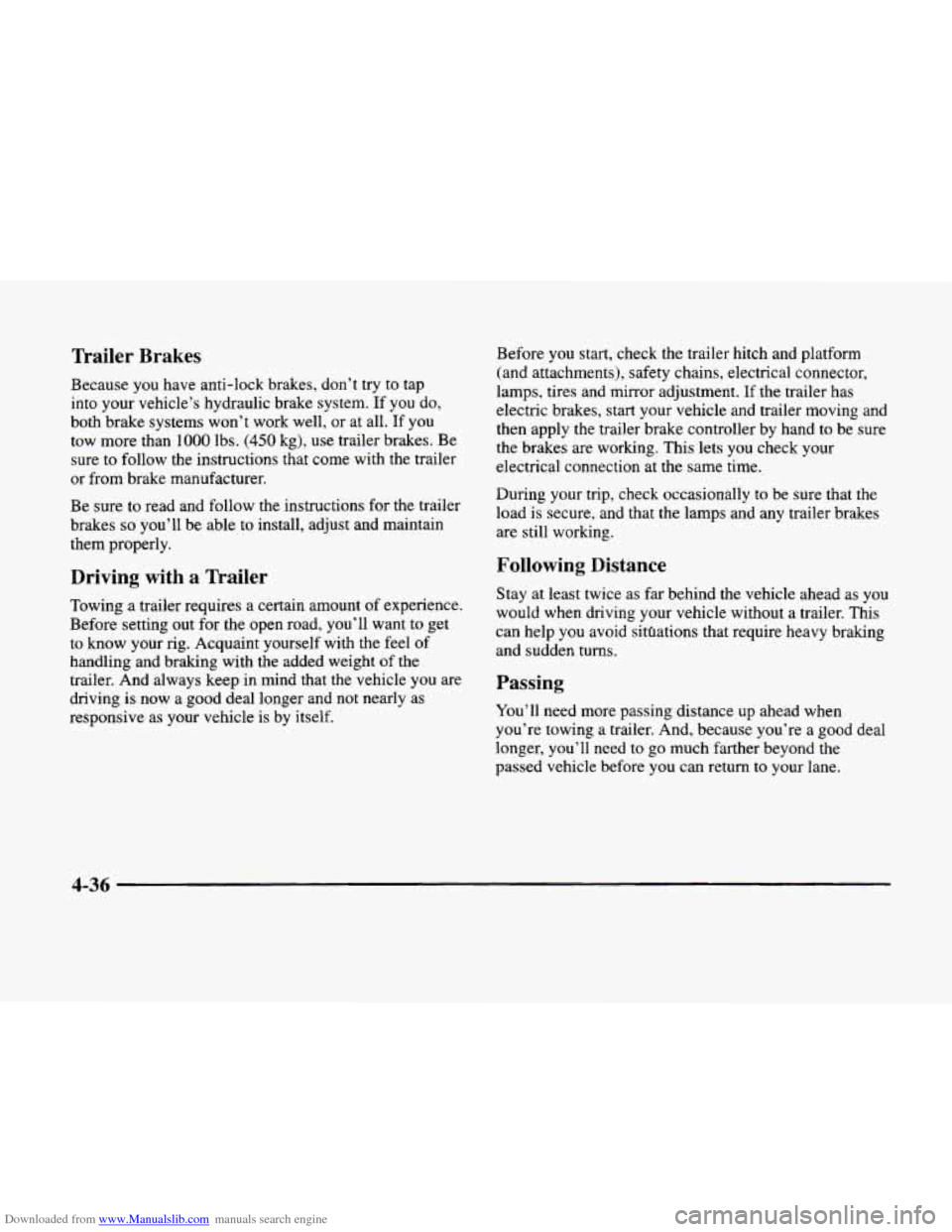
Downloaded from www.Manualslib.com manuals search engine Trailer Brakes
Because you have anti-lock brakes, don’t try to tap
into your vehicle’s hydraulic brake system. If you do,
both brake systems won’t work well, or at all. If you
tow more than
1000 lbs. (450 kg), use trailer brakes. Be
sure to follow the instructions that
come with the trailer
or from brake manufacturer.
Be sure to read and follow the instructions for the trailer
brakes
so you’ll be able to install, adjust and maintain
them properly.
Driving with a Trailer
Towing a trailer requires a certain amount of experience.
Before setting out for the open road, you’ll want to get
to know your rig. Acquaint yourself with the feel of
handling and braking with the added weight of the
trailer. And always keep in mind that the vehicle you
are
driving is now a good deal longer and not nearly as
responsive as your vehicle
is by itself. Before
you start, check the trailer hitch and platform
(and attachments), safety chains, electrical connector,
lamps, tires and mirror adjustment. If the trailer has
electric brakes, start your vehicle and trailer moving and
then apply the trailer brake controller by hand
to be sure
the brakes are working. This lets
you check your
electrical connection at the same time.
During your trip, check occasionally
to be sure that the
load is secure, and that the lamps and any trailer brakes
are still working.
Following Distance
Stay at least twice as far behind the vehicle ahead as you
would when driving your vehicle without a trailer. This
can help you avoid sithations that require heavy braking
and sudden turns.
Passing
You’ll need more passing distance up ahead when
you’re towing a trailer. And, because you’re a good deal
longer, you’ll need to
go much farther beyond the
passed vehicle before you can return
to your lane.
4-36
Page 236 of 380
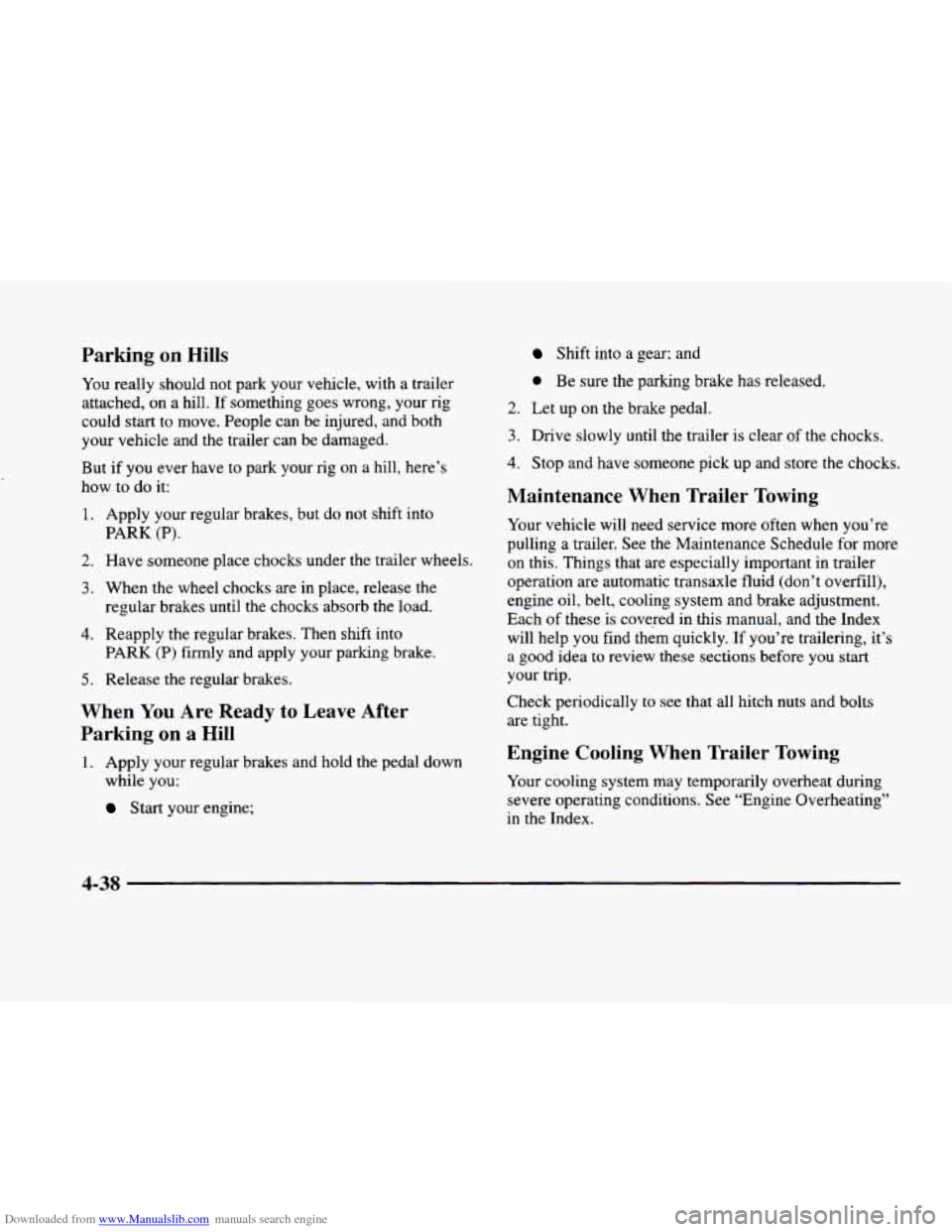
Downloaded from www.Manualslib.com manuals search engine Parking on Hills Shift into a gear; and
a Be sure the parking brake has released.
You really should not park your vehicle, with a trailer
attached, on
a hill. If something goes wrong, your rig
could start
to move. People can be injured, and both
your vehicle and the trailer can be damaged.
But if you ever
have to park your rig on a hill, here’s
how to
do it:
1. Apply your regular brakes, but do not shift into
PARK (P).
2. Have someone place chocks under the trailer wheels.
3. When the wheel chocks are in place, release the
regular brakes until the chocks absorb the load.
4. Reapply the regular brakes. Then shift into
5. Release the regular brakes.
PARK (P) firmly and apply your parking brake.
When You Are Ready to Leave After
Parking on
a Hill
1. Apply your regular brakes and hold the pedal down
while you:
Start your engine;
2. Let up on the brake pedal.
3. Drive slowly until the trailer is clear of the chocks.
4. Stop and have someone pick up and store the chocks.
Maintenance When Trailer Towing
Your vehicle will need service more often when you’re
pulling a trailer. See the Maintenance Schedule for more
on this. Things that are especially important in trailer
operation are automatic transaxle fluid (don’t overfill),
engine oil, belt, cooling system and brake adjustment.
Each
of these is covered in this manual, and the Index
will help you find them quickly. If you’re trailering, it’s
a good idea to review these sections before you start
your trip.
Check periodically
to see that all hitch nuts and bolts
are tight.
Engine Cooling When Trailer Towing
Your cooling system may temporarily overheat during
severe operating conditions. See “Engine Overheating”
in the Index.
4-38
Page 264 of 380
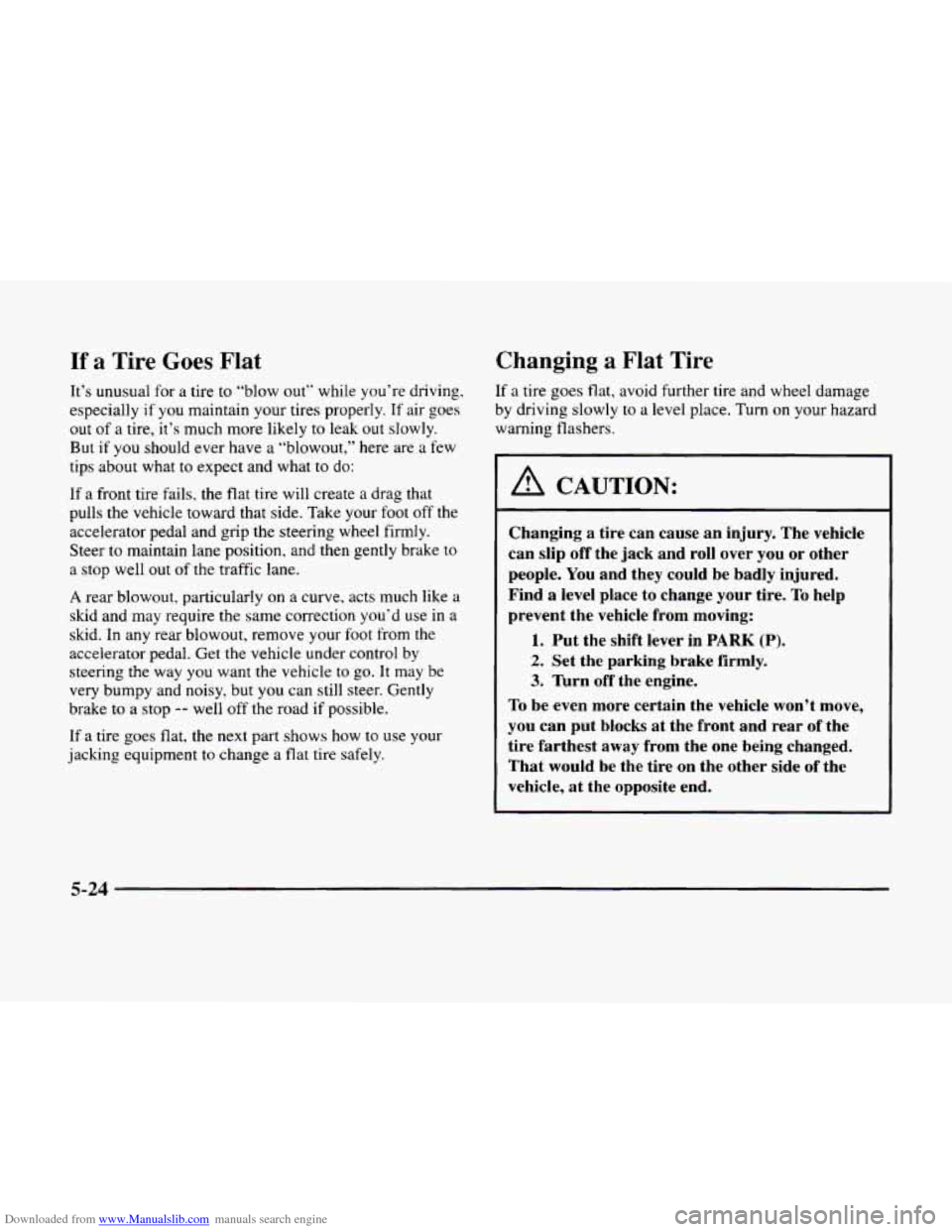
Downloaded from www.Manualslib.com manuals search engine If a Tire Goes Flat
It’s unusual for a tire to “blow out” while you’re driving.
especially
if you maintain your tires properly. If air goes
out
of a tire, it’s much more likely to leak out slowly.
But if you should ever have a “blowout,” here are
a few
tips about what
to expect and what to do:
If a front tire fails, the flat tire will create a drag that
pulls the vehicle toward that side. Take your foot off the
accelerator pedal and grip the steering wheel firmly.
Steer to maintain lane position, and then gently brake
to
a stop well out of the traffic lane.
A rear blowout, particularly on a curve. acts much like a
skid and may require the same correction you’d use in a
skid. In any rear blowout, remove your foot from the
accelerator pedal. Get the vehicle under control by
steering the way
you want the vehicle to go. It may be
very bumpy and noisy, but you can still steer. Gently
brake
to a stop -- well off the road if possible.
If
a tire goes flat, the next part shows how to use your
jacking equipment to change a flat tire safely.
Changing a Flat Tire
If a tire goes flat, avoid further tire and wheel damage
by driving slowly
to a level place. Turn on your hazard
warning flashers.
I A CAUTION:
Changing a tire can cause an injury. The vehicle
can slip
off the jack and roll over you or other
people.
You and they could be badly injured.
Find
a level place to change your tire. To help
prevent the vehicle from moving:
1. Put the shift lever in PARK (P).
2, Set the parking brake firmly.
3. lhrn off the engine.
To be even more certain the vehicle won’t move,
you can put blocks
at the front and rear of the
tire farthest away from the one being changed.
That would be the tire on the other side
of the
vehicle,
at the opposite end.
5-24
Page 299 of 380
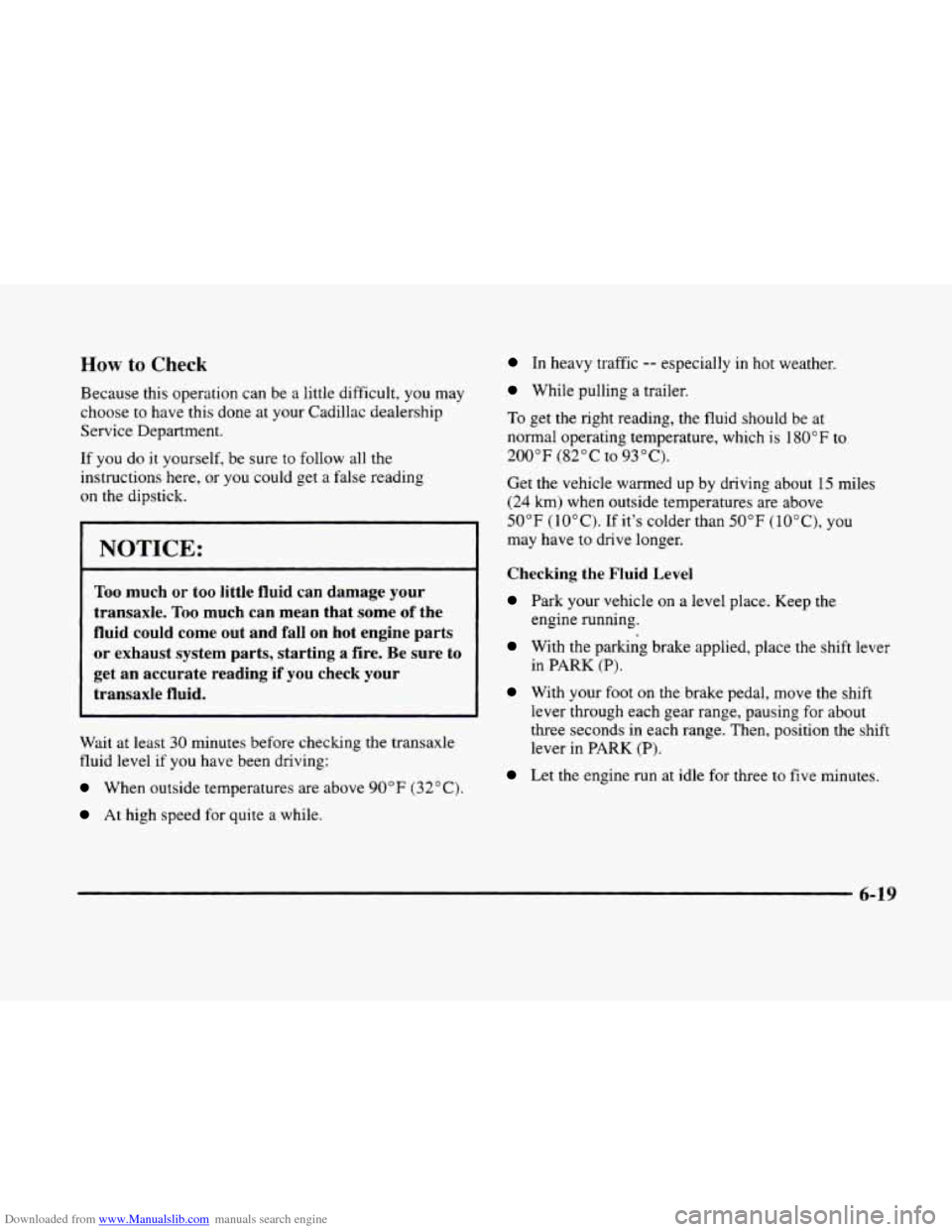
Downloaded from www.Manualslib.com manuals search engine How to Check In heavy traffic -- especially in hot weather.
Because this operation can be
a little difficult, you may While pulling a trailer.
choose
to have this done at your Cadillac dealership To get the right reading, the fluid should be at
Service Department.
normal operating temperature, which is 180°F to
If
you do it yourself, be sure to follow all the 200°F (82°C to 93°C).
instructions here, or
you could get a false reading Get the vehicle warmed up by driving about 15 miles
on the dipstick.
(24 kmj when outside temperatures are above
50°F (10"Cj. If it's colder than 50°F (lO°C), you
may have to drive longer.
Checking the Fluid Level
NOTICE:
Too much or too little fluid can damage your
transaxle.
Too much can mean that some of the
fluid could come out and fall on hot engine parts
or exhaust system parts, starting a fire. Be sure to
get an accurate reading if you check your
transaxle fluid.
Wait at least 30 minutes before checking the transaxle
fluid level if
you have been driving:
When outside temperatures are above 90°F (32°C).
At high speed for quite a while.
Park your vehicle on a level place. Keep the
With the parlung brake applied, place the shift lever
engine running.
in PARK
(P).
With vour
foot on the brake pedal, move the shift
lever ihrough each gear range, pausing
for about
three seconds in each range. Then, position the shift
lever in PARK
(P).
Let the engine run at idle for three to five minutes.
6-19
Page 301 of 380
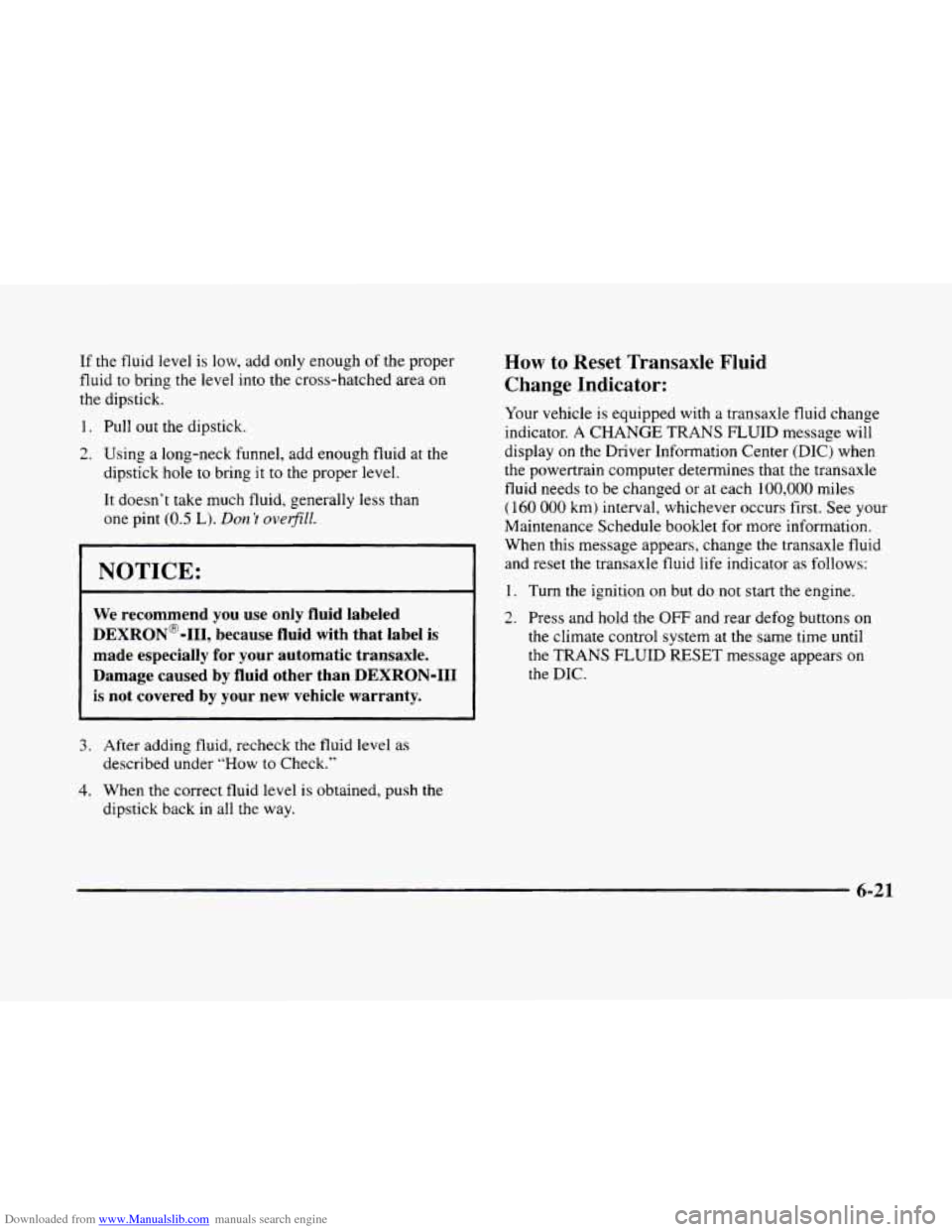
Downloaded from www.Manualslib.com manuals search engine If the fluid level is low, add only enough of the proper
fluid to bring
the level into the cross-hatched area on
the dipstick.
1. Pull out the dipstick.
2. Using a long-neck funnel, add enough fluid at the
dipstick hole
to bring it to the proper level.
It doesn’t take much fluid, generally less than
one pint
(0.5 L). Don’t ovegi’ll.
-
NOTICE:
We recommend you use only fluid labeled
DEXRON@-111, because fluid with that label
is
made especially for your automatic transaxle.
Damage caused by fluid other than DEXRON-I11
is not covered by your new vehicle warranty.
3. After adding fluid, recheck the fluid level as
described under “How
to Check.”
4. When the correct fluid level is obtained, push the
dipstick back
in all the way.
How to Reset Transaxle Fluid
Change Indicator:
Your vehicle is equipped with a transaxle fluid change
indicator.
A CHANGE TRANS FLUID message will
display
on the Driver Information Center (DIC) when
the powertrain computer determines that the transaxle
fluid needs to be changed or at each
100,000 miles
(160 000 km) interval, whichever occurs first. See your
Maintenance Schedule booklet for more information.
When this message appears, change
the transaxle fluid
and reset the transaxle fluid life indicator as follows:
1. Turn the ignition on but do not start the engine.
2. Press and hold the OFF and rear defog buttons on
the climate control system at the same time until
the TRANS FLUID RESET message appears on
the DIC.
6-21